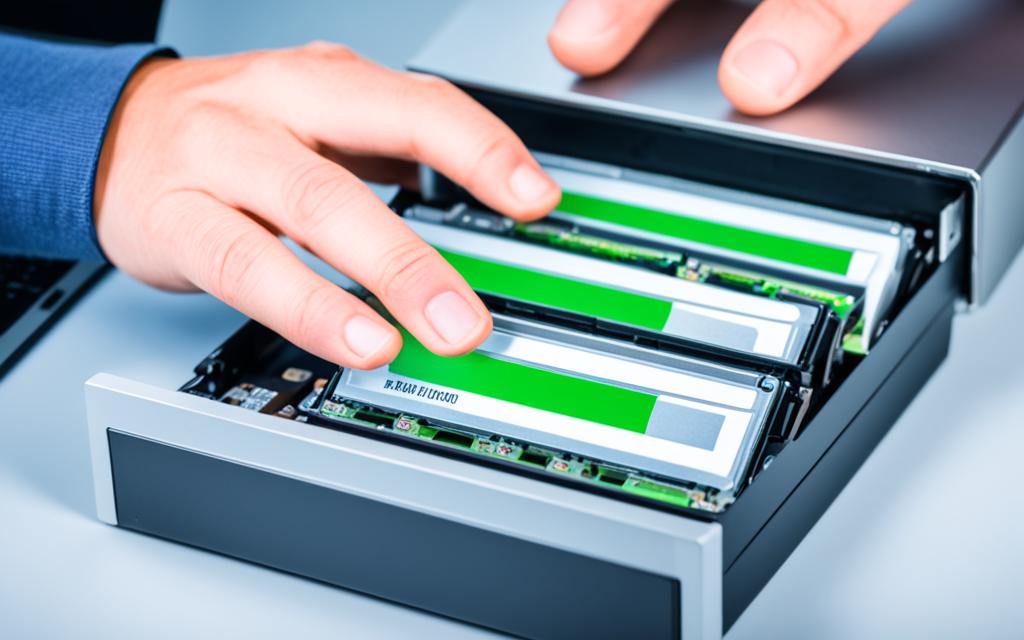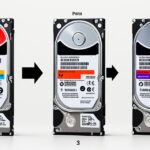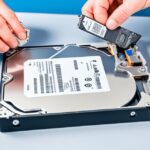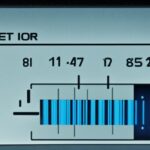Table of Contents
Partitioning an external hard drive helps you manage data better. You divide the HDD into sections for organised storage. It’s crucial for those needing separate spaces for files, backups, or different systems1. Windows offers a simple way to do this with its Disk Management tool. This is great for beginners2.
By learning to partition, you keep data safe and make your drive work better. Your needs and how you use the drive decide how to divide it. Each partition has its own purpose3.
Key Takeaways
- Partitioning enhances data organisation and performance of an external HDD.
- Windows simplifies the partitioning process through its built-in Disk Management tool.
- Data backup is crucial before undertaking partitioning to prevent data loss.
- Different file systems should be considered based on the operating system used.
- Understanding your usage needs is essential for effective partitioning.
- Quick and full formats serve different purposes during drive preparation.
- Partitioning enables a safer environment for managing and securing important files.
Understanding the Basics of Partitioning
Partitioning a hard drive makes data storage more efficient. It divides a hard drive into smaller parts called partitions. Each partition acts like its own drive, making it easy to organise and manage data. For instance, you can split a 500GB drive for different uses. You might want one part for your operating system and another for personal files. This way, you can keep your data tidy and secure sensitive information with ease4.
What is Partitioning?
The idea behind partitioning definition is simple. It’s about arranging storage on a disk smartly. A traditional disk can have up to four partitions. These can be primary or extended5. If you need more than four, you create more primary ones and an extended partition for additional spaces5. Partitioning is key for setting up storage devices. You need at least one partition for hard disks, USB drives, and SD cards to work5.
Why Should You Partition a Drive?
Partitioning brings many benefits. It helps organise data well, making it simpler to back up and restore4. It’s also great for running different operating systems on one drive. By keeping different types of data separate, you can protect against widespread corruption5. Even though partitioning doesn’t directly speed up your computer, managing space well can keep it running smoothly4.
Preparing for Partitioning
Before you start splitting an external hard drive into parts, you need to prepare. Good preparation can smooth out the whole process. It also reduces the chance of any problems happening.
Backing Up Your Data
It’s very important to back up your data before you start partitioning. Partitioning might cause you to lose data. So, it’s smart to keep all important data safe beforehand. You can use online storage or extra hard drives for backup. This way, your data is safe if something unexpected happens while you’re partitioning.
Requirements for Partitioning
To partition correctly, you need to know what your system requires. Windows PCs usually use NTFS for external drives. They also offer exFAT for Mac compatibility. Windows has built-in tools for creating new partitions easily. With the Master Boot Record (MBR) scheme, you can make up to four primary partitions. But, if you use the GUID Partition Table (GPT) scheme, you can have up to 128 partitions67. Remember, formatting an external drive can take some time. So, be patient as you get ready for this6.
https://www.youtube.com/watch?v=Wmlpup2lIYI
How to Partition an External HDD
Partitioning an external hard drive helps you organise your data better. It allows for different uses and can even boost performance. With Windows’s Disk Management tool, users can manage partitions easily. This tool is part of Windows 10/8/7. It supports actions like making a partition bigger or smaller. Users find it easy to create new partitions, making it favoured by many2.
Using Windows Disk Management
The user interface of Windows Disk Management is easy to use. It shows all drives connected to your computer. To start, type “Disk Management” in the Windows search bar. To create a partition on Windows, you need unallocated space on your external HDD. If you don’t have this space, you’ll need to shrink an existing volume. Right-click the volume you want to shrink and select ‘Shrink Volume’. This will leave unallocated space, ready for a new simple volume1
Steps to Create a New Partition
Here are the steps to start partitioning:
- Open Disk Management: Find it using the Windows search bar.
- Shrink Volume: Right-click an existing volume and click ‘Shrink Volume’ to make space.
- Create New Simple Volume: Then, right-click on the new unallocated space and select ‘New Simple because Volume’.
- Follow the Wizard: Go through the wizard to decide the volume size, assign a drive letter, and choose the file system you want, like NTFS or exFAT.
Partitioning makes managing your files easier, offering better security and organisation. By having different places for various data types, you cut down on confusion. This makes your external hard drive work more efficiently18.
| Action | Description |
|---|---|
| Shrink Volume | Makes an existing partition smaller to leave space unallocated. |
| Create New Simple Volume | Helps set up a new partition on the open space. |
| Assign Drive Letter | Makes it easier for users to spot and access the new partition in Windows Explorer. |
| Format Partition | Gets the partition ready for storing data in the selected file system. |
Formatting Your New Partitions
After creating your partitions, the next step is formatting them. This makes sure they work with your operating system. Formatting sets up a file system. This system helps your computer to read and write data on the partition.
Types of Formatting: Quick vs Full
You can choose between a quick format and a full format. A quick format quickly removes files but doesn’t delete them fully. This means you can still recover the old data. A full format, however, clears the data completely and checks for errors. It’s more secure.
Choose based on your need for security. For instance, if you have sensitive info on a 3.7 terabyte drive, a full format is better9.
Choosing the Right File System
Choosing the right file system is essential for saving data successfully. For Windows, the NTFS system is suggested. It can handle big files and helps protect your data. If you share files across different systems, use exFAT because it works everywhere.
Before you finish setting up your partition, don’t forget free space on your C: drive10. And, always back up your partitions to avoid losing data10.
Understanding your formatting choices affects your drive’s performance and security. Whether it’s for personal or business use, picking the right format and file system is key.
Utilising GParted for Partitioning
GParted is a robust free tool for Linux disk management. It’s perfect for anyone wanting to handle partitions easily. By using the GParted guide, you can learn how to partition smoothly.
Installation and Setup of GParted
Installing GParted is straightforward. Just type sudo apt-get install gparted into the terminal. After installation, plug in your external hard drive. You can then start GParted from your applications menu. Remember, your external drive needs to be unmounted before making changes. GParted does this for you, making the process simple.
Step-by-Step Guide to Partitioning with GParted
To partition effectively with GParted, follow these steps:
- Open the GParted app.
- Pick your external HDD from the top right dropdown list.
- Right-click on the space you want to change.
- Decide if you’re creating a new partition or resizing an old one.
- Choose the right file system, like FAT32 or NTFS, for your OS.
- Hit the Apply button to make the changes happen.
For extra help, look at the GParted Live manual. With a little practice, you’ll be managing partitions expertly, boosting your disk’s performance.
Conclusion
Partitioning an external HDD enhances its usefulness greatly. By partitioning, you can sort your files more easily. This makes finding what you need faster and more straightforward. Tools like Windows Disk Management and AOMEI Partition Assistant have great features. They let users start up new drives, encrypt parts for better security, and make backing up easier. These are major advantages of partitioning.
As managing external HDDs gets more important, learning these skills is valuable. It gives people powerful storage options. The ability to run different operating systems or speed up data access makes everything more organised. This is especially vital for professionals with a lot of data. Yet, it’s important to know that multiple partitions can bring challenges, like security risks or the chance of filling up your storage too much.
To manage your digital stuff better, it’s key to understand your storage needs and how to partition effectively. Looking for more tips on tech? Check out this link for more on optimizing your devices111213.
FAQ
What is the purpose of partitioning an external HDD?
Partitioning an external HDD divides it into smaller sections. This makes it easier to manage your data. It also boosts performance and provides storage solutions for different needs.
Do I need to back up my data before partitioning?
Yes, backing up your data before partitioning is essential. It ensures your important files are safe. This way, you prevent losing them during the partitioning process.
How can I access Windows Disk Management?
Access Windows Disk Management by searching for it in the search bar. It’s a tool that helps manage partitions. It shows all drives, including external ones.
What are the differences between a quick format and a full format?
A quick format deletes files but doesn’t fully erase them, allowing for possible recovery. A full format erases everything and checks for bad sectors. It cleans the drive completely.
How can I install GParted on my Linux system?
To install GParted, enter `sudo apt-get install gparted` in a terminal. After installing, connect your external HDD. Then launch GParted from the applications menu to start partitioning.
What file systems can I choose during formatting?
You can choose from NTFS, FAT32, or exFAT when formatting. Your choice should depend on how you plan to use the partition. Consider device compatibility as well.
Why is it important to understand partitioning tools?
Knowing how to use tools like Windows Disk Management and GParted is key. They help you manage your storage better. This leads to better data organisation and control over digital assets.
Source Links
- https://www.androidauthority.com/format-partition-external-hard-drive-windows-3184818/ – How to format and partition an external hard drive or SSD on Windows
- https://www.easeus.com/partition-master/free-partition-external-hard-drive-windows-10.html – How to Partition External Hard Drive in Windows 11/10/8/7
- https://www.salvagedata.com/how-to-partition-external-hard-drives-on-windows-and-mac/ – How to Partition External Hard Drives Without Losing Data (Windows & macOS) – SalvageData
- https://www.lenovo.com/us/en/glossary/how-to-partition-a-hard-drive/ – Step-by-Step Hard Drive Partitioning | Lenovo US
- https://www.howtogeek.com/184659/beginner-geek-hard-disk-partitions-explained/ – Beginner Geek: Hard Disk Partitions Explained
- https://www.hellotech.com/guide/for/how-to-format-a-hard-drive-windows-10 – How to Format an External Hard Drive on Windows 10 or 11 : HelloTech How
- https://www.ninjaone.com/blog/how-to-partition-a-hard-drive-in-windows-10/ – How to Partition a Hard Drive in Windows 10 | NinjaOne
- https://www.crucial.com/articles/external-ssd/how-to-partition-an-external-ssd – How to partition an external SSD
- https://forums.linuxmint.com/viewtopic.php?t=373863 – Can i create a new partition on my external hdd without formatting it ?
- https://www.pcmag.com/how-to/how-to-partition-a-hard-drive – Time to Split: How to Partition a Hard Drive in Windows
- https://www.diskpart.com/articles/how-to-partition-external-hard-drive-without-losing-data-1881.html – How to Partition External Hard Drive without Losing Data?
- https://www.stellarinfo.com/article/should-you-partition-your-hard-drive-pros-and-cons.php – Should You Partition Your Hard Drive? The Pros and Cons
- https://superuser.com/questions/1749727/how-to-make-best-use-of-only-good-sectors-partitions-on-a-semi-faulty-hdd – How to make best use of only good sectors/partitions on a semi-faulty HDD?








